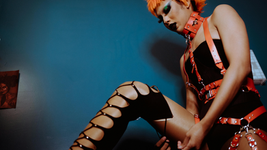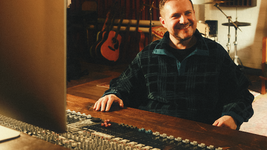"I see Luanda as our studio": In Conversation with Director Ery Claver
- Lauren Zanker
- Nov 4, 2022
- 5 min read
Before sitting down with Ery Claver, writer/ director of Our Lady of the Chinese Shop, I could not have guessed how his answers would alter my perspective on both the film and filmmaking in general. I never expected a film that was so perfectly assembled to be filmed in a totally free and unrestricted way. His use of the city as his playground was truly fascinating, however, I will let Ery’s answers speak for themselves:
Lauren Zanker: How did you begin your journey of filmmaking? Is it something you’ve always wanted to do?
Ery Claver: Not at all, not at all. Since I was a teenager, I was always a good cinephile. I always liked movies. But at a certain point, I was much more interested in literature. So I went in the afternoons, for example, to the National Library in Luanda and I started to read some books about cinema.
But the funny thing is, I always had the chance to read the films. We, at the time, didn’t have the cinemas, even now, we don’t have many cinemas, so I wasn’t able to watch the movies that I spent my teenage years reading about! By that time, I started to do a similar thing with photography, I take one photo and then invented a story for this photo.
So, I started from the very bottom with images and movement. And then went to video. But I never really liked video because the image was too… how can I put this… at the time we didn’t have the cinematic aspect… it was like TV format. But now, we have better cameras at a lower price.

Credit: Noise Film and TV
LZ: What made you want to tell this story?
EC: Well, it started from a lot of different stories because I have characters in Our Lady that came from my short films. So that’s why sometimes I forgot the audience because most of the characters I’ve been developing in different short films - they already existed. They are in different formats. In this movie, maybe I was not able to tell the depth of their stories - because I (felt) like I, personally, know a lot about them. And I didn’t think about the audience!
Sometimes people ask me how is Luanda. What represents Luanda? What does it really mean to be Luandans? But I was born and raised here, I’ve always lived here, and I can’t answer these questions. I don’t know. Because it’s different feelings. You can’t even imagine (the different feelings) in a big city like this. So I say, I want to challenge reality because our reality is so fucked up… I wanted to infiltrate reality and change things and try to create an allegorical feeling about us. So I had to find different ways to understand this (city). Because I’m really in it, I’m not a person outside. Sometimes people from the outside, they have this kind of idea about us which, in reality, is completely different.
LZ: I found Luanda a really beautiful and interesting setting. As you are from there, what about the city makes it so unique and essential to this story?
EC: When you think about South Africa, the feelings of people and the mood, they are happy people. And that’s who we are. We are always dancing, partying, we don’t care about our struggles, we say ‘never mind, I only have one life’.
And it’s like that, but we have the other side of the coin. Because people accumulate a lot of pain. And at some point, this pain will blow up, because you can’t consume so much pain. I wanted to make a film that represents this moment, the feelings of the people, and how they deal with pain.
Thirty years ago, we dealt with Portuguese people, so we have (their) Catholic stuff, these Catholic churches – Brazilian evangelic churches. Now, religion is impregnated in the people’s minds but in a different way – in an even more aggressive way. They are very aggressive with things like business, power – and even more aggressive with how they invaded our city.
But the Chinese, they are very sympathetic with us… So, I had this idea: what if (the Chinese) controlled the main thing which is faith? But what is interesting is that they are not represented in the city. I don’t have any Chinese friends. But they control entire neighbourhoods. But you don’t see them, maybe inside the stores, but outside you don’t see them. You can see a neighbourhood full of Chinese symbols and papers, but you don’t see any of them. So, they dominated in a sort of ghost way – they’re here but they’re not here.
LZ: It’s like the narrator in the film! You can always hear him, but you don’t really see him.
EC: Yeah! The thing is, I didn’t want to offend them. I tried to reach out to some Chinese people – I talked with maybe five guys only. Five people. They weren’t able to talk with me about the movie because they cannot compromise with the (rules) in a different country, they have their regulations. So it was really difficult for them to participate. But I found the manager of Chinatown in Luanda – and he was the person to say ‘okay, I’m the boss, you can make (the film)’.

Credit: Noise Film and TV
LZ: I was struck by how It felt like I was truly on the Luandan streets. Did this involve a lot of improvisation or was it very structured?
EC: I see Luanda as our studio, you know? Because it is a big city, but at the same time it’s so small because everybody knows everybody. And I previously spent 8 years working in national television doing all the reports, in the neighbourhoods, in the underground streets, so I know a lot of people, and a lot of people know me. In some scenes, we didn’t make a crew schedule or anything. Scenes with Zoyo (Rebeiro), was just me and him and the camera – all by ourselves. We started walking, walking, walking, finding people, then ‘let’s make a conversation with them!’.
LZ: Did you find there were any unexpected challenges when filming? Did some things not go as you had originally planned?
EC: Of course! One of the main scenes of the movie was not supposed to be like that at all: the arena. When I wrote that scene, I didn’t write a script at all, I wrote a big poem. When I wrote, I imagined a big crowd of people... Because of the pandemic situation, we were not able to put people there. Even if we could, it would be a complete nightmare. So, because of COVID, we were not able to do it like that. We had an idea to put some clothes there instead of people.
That building is very iconic in our city but was never shot by anyone, no filmmaker, no photographer. Thirty years like this, untouched. For me, I like to shoot like a documentary, I like things real. I don’t like to interfere with reality. Most of the scenes, like the arena, were all spontaneous. Just, let’s see where it goes.
LZ: Lastly, as this is your first feature film, what kind of stories would you want to tell going forward?
EC: I don’t know because I never think about one story specifically. I’m always dealing with different (ones). What motivates me is not one story only. I like to mix things up, all fragmented. I like to feel different vibes. Just like Luanda, it’s not one thing only – you can walk down the same street, the same place, and have different feelings. So, I always think about different kinds of stories.
But I’m not thinking right now of doing a personal project, maybe not until the end of the next year.
Edited by Barney Nuttall, Deputy Film Editor


































Comments